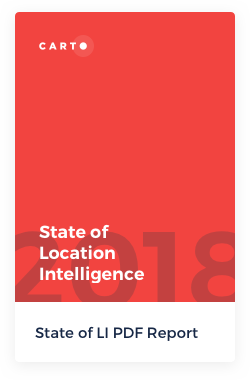Welcome To the Report
In 2020, there will be 20.4 billion connected “things” in use, up from 8.4 billion in 2017. From smartphones to sensors to appliances to stoplights, the exponential growth of connected devices (dubbed the Internet of Things) is creating an overwhelming amount of data about what we do, how we do it, and where it happens.
CARTO partnered with Hanover Research, a respected market research firm, to bring you The State of Location Intelligence 2018.
We surveyed over 200 business executives, data analysts, and business analysts and our data shows that businesses executives and data practitioners see Location Intelligence as critical to their organization’s success.
Our goals for The State of Location Intelligence 2018 were to understand:
- How crucial business leaders saw LI with respect to the success of their companies.
- The most common and useful business applications of LI across industries.
- The challenges that business executives and data practitioners saw when it comes to adopting Location Intelligence.
- What successful businesses are doing to better prepare themselves for the rising importance of location data.
WHAT’S LI?
LI is a discipline that helps organizations turn location data into business outcomes through enrichment of data, visualization, and iterative analysis.
01
The State of Location Data
Nearly all medium and large organizations collect and store location data. Business executives know that Location Intelligence (turning that location data into business outcomes) will be crucial to their success.
Location Data is nearly ubiquitous at companies with over 500 people. 94% of C-level respondents said that their organization collects and/or stores location data.
Does your organization collect and/or store location data?
-
YES
94%
-
NO
6%
The Challenges of Location Intelligence
There is a gap in the understanding of location data’s value, the practical applications, and challenges to adoption (among other things) between executive management and data practitioners.
For example, C-level respondents were more aware of methods for collecting location data and interestingly, also more aware of the challenges than analysts.
How does your organization collect Location Data?
- Chief level
- Analyst
Web
-
57%
-
40%
Mobile devices
-
54%
-
44%
Client Data
-
51%
-
38%
Customer Service Interactions
-
47%
-
50%
Cross-department data
-
45%
-
23%
E-commerce
-
45%
-
31%
Location-based services offered
-
45%
-
25%
Point-of-Sale system
-
43%
-
21%
GPS Devices
-
43%
-
23%
Publicly available data
-
41%
-
23%
Hardware, Sensors, or chips
-
41%
-
6%
Social Media
-
28%
-
13%
Third-party location data provider
-
24%
-
17%
Paper and/or online forms
-
24%
-
25%
Other
-
0%
-
2%
I don’t know/ not sure
-
0%
-
8%
02
03
The Future of Location Intelligence
Businesses must focus on implementing LI best practices and methods across their organizations.
Most businesses use geographic boundaries at a state or zip-code level, but few visualize or analyze their spatial data with more granular boundaries. Only 27% said they use any kind of custom geography and 17% use block groups (the most granular level that Census data provides). To understand location data, businesses must begin visualizing and analyzing at a deeper geographic level.
Which of the following geographic levels does your organization typically use?
- 100% -
- 50% -
- 0% -
-
76%
State
-
72%
Region
-
69%
City
-
68%
Zip Code
-
64%
Country
-
31%
Physical Store
-
27%
Lat / Long
-
26%
Custom Geo
-
26%
Virtual Location
-
17%
Block Groups
-
0%
Other
-
0%
Don't know
Download full report
Want to read the complete report about Location Intelligence? Fill this form below to get access to dozens of charts, insights, and resources for future learning.
